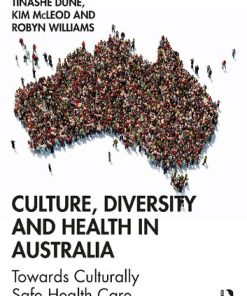Underserved and Socially Disadvantaged Groups and Linkages with Health and Health Care Differentials 1st Edition by Jennie Jacobs Kronenfeld ISBN 9781838670566 1838670564
$50.00 Original price was: $50.00.$25.00Current price is: $25.00.
Underserved and Socially Disadvantaged Groups and Linkages with Health and Health Care Differentials 1st Edition by Jennie Jacobs Kronenfeld – Ebook PDF Instant Download/Delivery: 9781838670566 ,1838670564
Full download Underserved and Socially Disadvantaged Groups and Linkages with Health and Health Care Differentials 1st Edition after payment

Product details:
ISBN 10: 1838670564
ISBN 13: 9781838670566
Author: Jennie Jacobs Kronenfeld
Underserved and Socially Disadvantaged Groups and Linkages with Health and Health Care Differentials 1st Edition Table of contents:
Part I. Introduction to Volume
Underserved and Socially Disadvantaged Groups and Linkages with Health and Health Care Differentials
Underserved and Socially Disadvantaged Groups and Other Social Factors as Linked to Health Dispariti
Health Inequalities, Health Care Inequalities, and Health Disparities
Underserved and Socially Disadvantaged Groups
Review of Contents of the Volume
References
Part II. Mental Health Related Issues
Disadvantage Begets Disadvantage? Exploring Mental Health Pathways for Girls of Color
Introduction
Method
Sample and Procedure
Measures
Analysis
Results
Discussion
References
Familial Support and Mental Health Service Use: Differences among First- and Second-generation Asian
Introduction
Family Support
Theoretical Background
Socioemotional Selectivity Theory
Modernization
Literature Review
Beliefs and Behaviors in Mental Health Services
Filial Piety
Familism
Western Influences
Shifts in Family Expectations and Networks
Data and Methods
Variables
Mental Health Service Use
Ancestry and Immigrant Generation
Familial Support
Controls
Results
Ancestry/Immigrant-generation and Mental Health Service Use
Sex, Marital Status, and Familial Support
Hypothesis 1
Hypothesis 2
Hypothesis 3
Hypothesis 4
Discussion and Limitations
Conclusion
References
Psychological Distress Differentials as a Function of Subjective Social Status among Latino Subgroup
Latino Groups Mental Health Differentials
Subjective SES and Mental Health
Statistical Analyses
Methods
Sample and Procedures
Measures
Psychological Distress
Subjective Social Status (SSS)
Sociodemographic Variables
Sociocultural Indicators
Objective Socioeconomic Status (SES)
Results
Descriptive Statistics and Preliminary Analyses
Multivariable Linear Regression Models
Subjective Social Status in the United States
Subjective Social Status in the Community
Discussion
Limitations
Conclusion
References
Part III. Other Health Problems
Race, Environmental Inequality, and Physical Health
Introduction
Background
Race and Environmental Risk
Environmental Risk and Physical Health
Hypotheses
Data
Measures
Environmental Toxins
Self-rated Physical Health
Race and Ethnicity
Socioeconomic Status
Background Variables
Statistical Procedures
Results
Toxin Exposures
Self-rated Physical Health
Mediation Analyses
Supplemental Analyses
Discussion
Conclusion
References
Autism Spectrum Disorders and the HealthCare Experiences of Aging Adults
Introduction
Research Purpose
Research Methods
Sampling Strategy
Ethical Issues: Human Subject Issues
Accommodations for Participant Recruitment
Findings
Informant Characteristics
Specific Aim 1
Clinical Accommodations
Clinical Accommodations: Sensory Needs
Clinical Accommodations: Environmental Adjustments
Clinical Accommodations: Utilizing Pediatric Providers
Communication Practices
Communication in the Clinical Environment
Communication with Guardians and Residential Caregivers
Patient Social/Behavioral Requirements
Transitioning On/Off Psychotropic Medications
Double Jeopardy Stigma of Ageism/Disability
Specific Aim 2
PCP Serving as Coordinator of Care/Services: Positive Experiences
PCP Serving as Coordinator of Care/Services: Less Positive Experiences
Role of Family Members in the Coordination of Care
Reliance on Caseworkers in Coordination of Care
Coordination of Care Challenges: Emergency Rooms
Coordination of Care Challenges: Preventive Health Services
Specific Aim 3
Barriers to Health: Access to Available Services
Barriers to Health: Medicaid Coverage
Barriers to Health: Group and Supported Residential Living
Advocacy: Influence on Ability to Serve
Discussion
Limitations
Conclusions and Future Work
The Provider Perspective and Sharing Best Practices
Alternative Care Settings to Prevent Injury and Reduce Emergency Room Use
Exploring the Medical Home Concept for Adults with ASD/ID
Understanding the Long-term Impact of Using Psychotropic Medications
References
Hepatitis C and Support Groups in Rural Communities
Background
The Effect of Hepatitis C on Social Class and Social Life
Social Environment in Rural Community
Purpose of This Study
Methods
Selecting Qualitative Inquiry
Institutional Review Board
Selecting Location
Collecting Data
Composite Descriptions of Study Sample
Findings
Community Members’ Perception of the Social Structures in Riverside
Changes in the Community
Increased Number of Patients with Hepatitis C
Increased Number of Low-income Families
“We Don’t Just Have Hepatitis”: Intentional Ignorance as a Way of Categorizing Undeserving Peo
Barriers to Forming a Support Group
Discrepancy on the Views of the Community’s Support System
Lack of Anonymity and Privacy
Discussion
Conclusion
References
“I Kinda Look Unhealthy, but I’m Not Unhealthy” – Exploring Rural Children’s Perspectives
Introduction
Purpose of the Study and Research Questions
Theoretical Framework
State of the Research: What Do We Know?
Significance of the Study
Midwest Town and Midwest Elementary School
Methods
Methodological Considerations in Research with Children
Participants
Data Collection
Ethnographic Observations
Games and Exercises
Student Interviews
Informed Consent
Data analysis
Preliminary Results
Knowing the Difference
Knowledge vs Choice
Time Constraints and Convenience
What’s Cooking?
Does Skinny Mean Healthy?
Family-specific Codes
Family Food Rules
Family Size and Structure
Physical Activity
Performance as a Health Incentive
The Blessing and Curse of Extra-curricular Activities
Self-exclusion from Recess and PE
Access
Would Better Access Really make People Choose “Healthy”?
Is Access a Matter of Time as Much or More Than Location?
Discussion: Open Questions and Next Steps
References
Part IV. Gender Concerns
Public Perception on Gender Issues and Women’s HealthCare Concerns Related to Leprosy: Implication
Introduction
The Problems
Brief Review of Literature on Gender Issues Related to Leprosy and Its Control across Some Societies
Research Questions
Hypothesis
Theoretical Framework
Materials and Methods
Research Findings
Sociodemographic Characteristics of Respondents
Analysis of Substantive Research Issues.
Gender-based Differences in Community Support and Post-treatment Integration
Test of Hypothesis
Discussion and Implications
References
Thalassemic Women’s Biographical Trajectory: Retracing Gender Inequalities in Health Policies
Introduction
Methods
Discussion of the Results
Conclusion
References
Part V. Health Care Workers
Work–life Balance in Medical Practice: The Reproduction of Patriarchy and the Politics of Gender
Introduction
Theoretical and Methodological Considerations
Data Selection
Findings
Defining Work–life Balance: The “Competing” Demands of Work and Life
Problems Related to Work–life Balance: Prioritizing Family over a Medical Career
Causes of Work–life Balance Tensions: Inherent Gender Roles and Behaviors
Recommendations to Address Work–life Balance Tensions: “Let Us Teach Them How to Cope”
Discussion
Practice, Policy Implications, and Recommendations
References
Vulnerable Caregivers: A Comparison of Direct Care Workers’ Health Risks in Skilled Nursing Facili
Introduction
Literature Review
Method
Findings
Worker Characteristics
Working Conditions
Injuries
Time for Tasks
Conclusion
References
The Health of Migrant Women Working as Home Care Assistants in Italy: An Analysis of the Most Hazard
Introduction
Home Care Assistants in Italy: The Job Contours
Home Care Workers’ Health Risks: Literature Review and Hypothesis
Research Design and Methods
Data Collection
Focus Groups
The Survey
Results
The Compound Effects of Emotional Work and Body Work
Cohabitation in the Domestic Space
Violence in the Workplace
People also search for Underserved and Socially Disadvantaged Groups and Linkages with Health and Health Care Differentials 1st Edition:
socially disadvantaged groups grant (sdgg)
underserved populations in social work
hhs underserved populations
what are some underserved populations
low-income and underserved students
Tags: Jennie Jacobs Kronenfeld, Socially Disadvantaged Groups, Health Care Differentials
You may also like…
Medicine - Therapy
Nutrition for Health and Health Care 8th Edition Linda Kelly Debruyne
Relationships & Lifestyle - Personal Growth & Inspiration
Uncategorized
Medicine - Others











